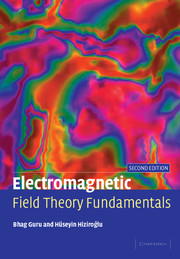Book contents
- Frontmatter
- Contents
- Preface
- Acknowledgments
- 1 Electromagnetic field theory
- 2 Vector analysis
- 3 Electrostatics
- 4 Steady electric currents
- 5 Magnetostatics
- 6 Applications of static fields
- 7 Time-varying electromagnetic fields
- 8 Plane wave propagation
- 9 Transmission lines
- 10 Waveguides and cavity resonators
- 11 Antennas
- 12 Computer-aided analysis of electromagnetic fields
- Appendix A Smith chart and its applications
- Appendix B Computer programs for various problems
- Appendix C Useful mathematical tables
- Index
7 - Time-varying electromagnetic fields
Published online by Cambridge University Press: 05 June 2012
- Frontmatter
- Contents
- Preface
- Acknowledgments
- 1 Electromagnetic field theory
- 2 Vector analysis
- 3 Electrostatics
- 4 Steady electric currents
- 5 Magnetostatics
- 6 Applications of static fields
- 7 Time-varying electromagnetic fields
- 8 Plane wave propagation
- 9 Transmission lines
- 10 Waveguides and cavity resonators
- 11 Antennas
- 12 Computer-aided analysis of electromagnetic fields
- Appendix A Smith chart and its applications
- Appendix B Computer programs for various problems
- Appendix C Useful mathematical tables
- Index
Summary
Introduction
In the study of static fields we concluded that (a) static electric fields are created by charges, (b) static magnetic fields are produced by charges in motion or steady currents, (c) the static electric field is a conservative field because it has no curl, (d) the static magnetic field is continuous because its divergence is zero, and (e) the static electric field can exist even when there is no static magnetic field and vice versa.
In this chapter, we show that a time-varying electric field can be produced by a time-varying magnetic field. We will refer to an electric field created by a magnetic field as an induced electric field or an emf-producing electric field. We will also highlight the fact that the induced electric field is not a conservative field. The line integral of an induced electric field around a closed path is, in fact, called the induced emf (electro-motive force). We will also discover that a time-varying electric field gives rise to a time-varying magnetic field. Simply stated, if there exists a time-varying electric (magnetic) field in a region, there also exists a time-varying magnetic (electric) field in that region. The equations describing the relations between electric and magnetic fields are known as Maxwell's equations because they were concisely formulated by James Clerk Maxwell. During the formulation of these equations, it will also become evident that Maxwell's equations are extensions of the known works of Gauss, Faraday, and Ampère.
- Type
- Chapter
- Information
- Electromagnetic Field Theory Fundamentals , pp. 276 - 350Publisher: Cambridge University PressPrint publication year: 2004



